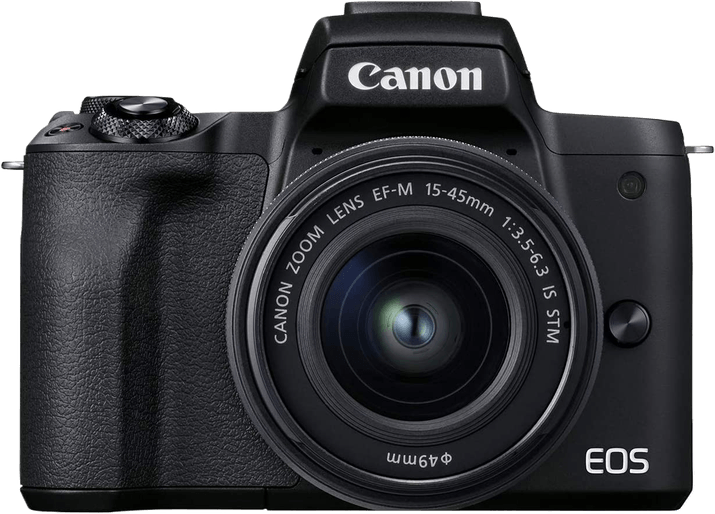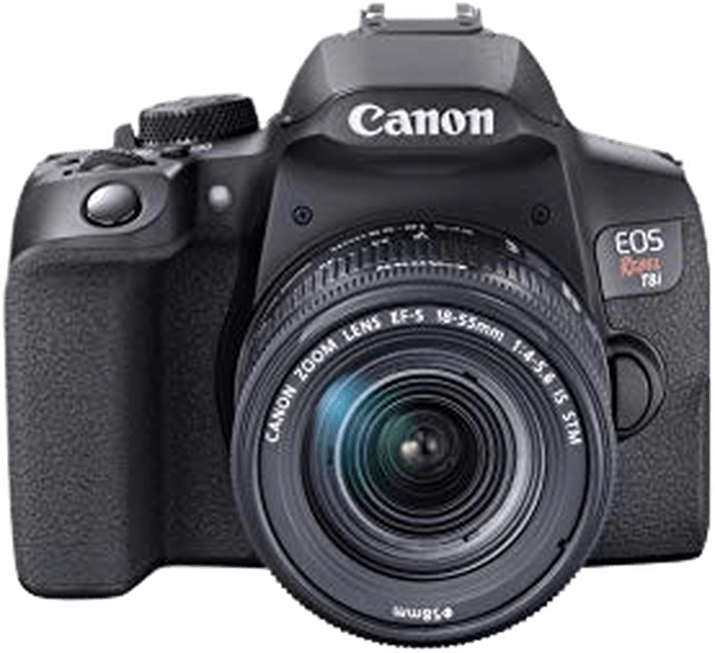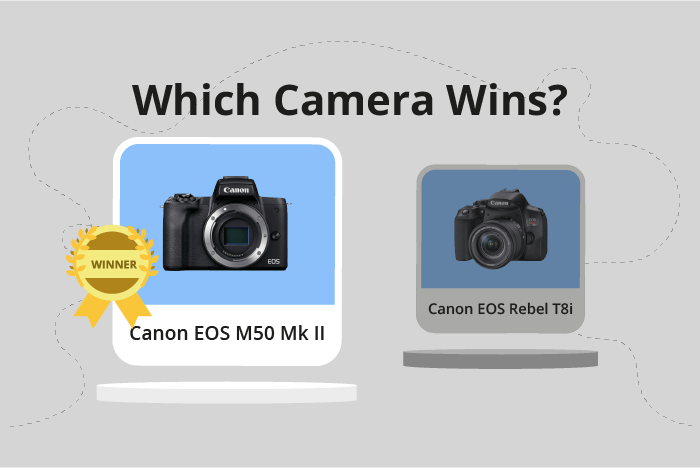Canon EOS M50 Mark II vs EOS Rebel T8i / 850D Comparison
Canon EOS M50 Mark II

Canon EOS Rebel T8i / 850D

The Canon EOS M50 Mark II and the Canon EOS Rebel T8i / 850D both have a score of 59/100, making it a tie in our comparison. These cameras share some common specs, such as their release year of 2020, announcement dates within two months of each other, and a launch price of $750.
The M50 Mark II, a mirrorless camera, has a smaller size (116 x 88 x 59mm) and is lighter (387g) compared to the Rebel T8i. This makes it more portable and convenient for on-the-go photography.
On the other hand, the Rebel T8i / 850D is a DSLR camera with a slightly larger size (131 x 103 x 76mm) and heavier weight (515g). This might offer a more substantial feel for those who prefer a heftier camera.
Since both cameras have the same score, it comes down to personal preference. The M50 Mark II is better for those seeking a lightweight and compact camera, while the Rebel T8i / 850D is suited for those who prefer a larger and more traditional DSLR feel.
Canon EOS M50 Mark II vs EOS Rebel T8i / 850D Overview and Optics
The Canon EOS M50 Mark II wins the optics comparison with a score of 59/100, while the Canon EOS Rebel T8i / 850D scores 57/100. Both cameras have 24 megapixels, CMOS sensors, Digic 8 processors, and APS-C sensor sizes. They also share the same DXOMARK score of 58 for the sensor and lack image stabilization.
The M50 Mark II has a faster shooting speed of 10 fps compared to the T8i’s 7.5 fps. This makes the M50 Mark II better for capturing fast-moving subjects and action photography. Additionally, the M50 Mark II uses the Canon EF-M lens mount, which is designed specifically for mirrorless cameras. This allows for a more compact and lightweight camera body.
On the other hand, the T8i uses the Canon EF/EF-S lens mount, which offers a wider range of compatible lenses, including those designed for full-frame cameras. This can be an advantage for photographers who already own Canon lenses or want more versatility in their lens choices.
While the M50 Mark II has a higher score and offers faster shooting speed and a more compact design, the T8i provides greater lens compatibility. Ultimately, the choice between these cameras depends on the photographer’s priorities and preferences. If faster shooting speed and a smaller camera body are more important, the M50 Mark II is the better choice. However, if a broader range of lens options is a priority, the T8i is the better camera.
Canon EOS M50 Mark II vs EOS Rebel T8i / 850D Video Performance
The Canon EOS M50 Mark II outperforms the Canon EOS Rebel T8i / 850D in video capabilities with a score of 91/100 compared to the T8i’s 83/100. Both cameras share some common specifications, such as 4K max video resolution and 3840 x 2160 max video dimensions. Additionally, both cameras have built-in time-lapse functionality.
The M50 Mark II takes the lead in video performance due to its higher max video frame rate of 120fps, which is double the frame rate of the T8i’s 60fps. This higher frame rate allows for smoother and more detailed slow-motion footage, making the M50 Mark II a better choice for videographers who prioritize capturing fast-paced action or intricate details in their videos.
On the other hand, the Canon EOS Rebel T8i / 850D does not hold any significant advantages over the M50 Mark II in terms of video capabilities. Both cameras share the same max video resolution and dimensions, as well as the time-lapse functionality. Therefore, the T8i does not outshine the M50 Mark II in any major aspect of video performance.
In comparing the video capabilities of these two cameras, the Canon EOS M50 Mark II is the clear winner due to its higher video score and superior max video frame rate. The Canon EOS Rebel T8i / 850D, although a capable camera, does not offer any distinct advantages over the M50 Mark II in video performance. Consequently, those looking for a camera with better video capabilities should consider the Canon EOS M50 Mark II over the Canon EOS Rebel T8i / 850D.
Canon EOS M50 Mark II vs EOS Rebel T8i / 850D Features and Benefits
The Canon EOS M50 Mark II and the Canon EOS Rebel T8i / 850D both have a feature score of 70/100. These cameras share several specifications, making them quite similar in terms of features. Both cameras have a 3-inch screen size, a screen resolution of 1,040,000 dots, a touchscreen, flip screen, and neither of them have GPS. Additionally, both cameras come with WIFI and Bluetooth capabilities.
The Canon EOS M50 Mark II excels due to its compact size and lighter weight, making it more portable and convenient for travel or on-the-go photography. This advantage allows photographers to carry the camera more comfortably and easily, resulting in a better shooting experience.
On the other hand, the Canon EOS Rebel T8i / 850D has a more robust and ergonomic design, providing a better grip and handling for photographers who prefer a more substantial feel. This design aspect can be beneficial for those who prioritize a more secure and comfortable hold on their camera while shooting.
Considering the shared specifications and features, both cameras offer a satisfactory user experience. The choice between the Canon EOS M50 Mark II and the Canon EOS Rebel T8i / 850D depends on individual preferences and priorities, such as portability or ergonomics. While the M50 Mark II is better for users seeking a compact and lightweight camera, the Rebel T8i / 850D is more suitable for those who prefer a sturdier and more ergonomic design.
Canon EOS M50 Mark II vs EOS Rebel T8i / 850D Storage and Battery
The Canon EOS Rebel T8i/850D wins in the storage and battery category with a score of 35/100, while the Canon EOS M50 Mark II scores 21/100. Both cameras have one memory card slot and accept SD, SDHC, and SDXC cards (UHS-I compatible). Neither camera offers USB charging.
The Rebel T8i/850D outperforms the M50 Mark II in battery life, providing 800 shots per charge compared to the M50 Mark II’s 305 shots. The T8i/850D uses the LP-E17 battery, which lasts longer than the M50 Mark II’s LP-E12 battery.
The M50 Mark II does not have any advantages over the Rebel T8i/850D in the storage and battery category. The Rebel T8i/850D’s superior battery life makes it a more reliable choice for extended photo sessions and reduces the need for frequent battery replacements or additional backup batteries.
In comparing the storage and battery aspects of the Canon EOS M50 Mark II and the Canon EOS Rebel T8i/850D, the Rebel T8i/850D is the clear winner due to its significantly longer battery life.
Canon EOS M50 Mark II vs EOS Rebel T8i / 850D – Our Verdict
Are you still undecided about which camera is right for you? Have a look at these popular comparisons that feature the Canon EOS M50 Mark II or the Canon EOS Rebel T8i / 850D:

